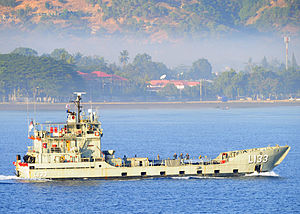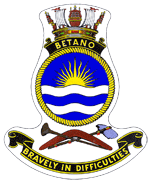HMAS Betano
 HMAS Betano in June 2011
| |
| History | |
|---|---|
| Builder | Walkers Limited |
| Laid down | September 1972 |
| Launched | 5 December 1972 |
| Commissioned | 8 February 1974 |
| Decommissioned | 12 December 2012 |
| Homeport | HMAS Coonawarra |
| Motto | "Bravely In Difficulties" |
| Honours and awards |
|
| Status | Awaiting disposal |
| Badge |  |
| General characteristics | |
| Class and type | Balikpapan-class landing craft heavy |
| Displacement | 316 tons |
| Length | 44.5 m (146 ft) |
| Beam | 10.1 m (33 ft) |
| Propulsion | Two GE diesels |
| Speed | 9 knots (17 km/h; 10 mph) |
| Capacity | 180 tons of vehicle cargo or 400 soldiers |
| Complement | 13 |
| Armament | 2 × 0.50 inch machine guns |
HMAS Betano (L 133) was a Balikpapan-class heavy landing craft operated by the Royal Australian Navy (RAN).
Design and construction
[edit]The eight-vessel Balikpapan class was ordered as a locally manufactured replacement for the Australian Army's LSM-1-class landing ship medium and ALC 50 landing craft.[3] They are 44.5 metres (146 ft) long, with a beam of 10.1 metres (33 ft), and a draught of 1.9 metres (6 ft 3 in).[4] The landing craft have a standard displacement of 316 tons, with a full load displacement of 503 tons.[4] They are propelled by two G.M. Detroit 6-71 diesel motors, providing 675 brake horsepower to the two propeller shafts, allowing the vessels to reach 9 knots (17 km/h; 10 mph).[4] The standard ship's company is 13-strong.[4] The Balikpapans are equipped with a Decca RM 916 navigational radar, and fitted with two 7.62 millimetres (0.300 in) machine guns for self-defence.[4]
The LCHs have a maximum payload of 180 tons; equivalent to 3 Leopard 1 tanks, 13 M113 armoured personnel carriers, 23 quarter-tonne trucks, or four LARC-V amphibious cargo vehicles.[4][5] As a troop transport, a Balikpapan-class vessel can transport up to 400 soldiers between a larger amphibious ship and the shore, or embark 60 soldiers[6] in six-berth caravans for longer voyages.[5] The vessel's payload affects the range: at 175 tons of cargo, each vessel has a range of 1,300 nautical miles (2,400 km; 1,500 mi), which increases to 2,280 nautical miles (4,220 km; 2,620 mi) with a 150-ton payload, and 3,000 nautical miles (5,600 km; 3,500 mi) when unladen.[4] The flat, box-like keel causes the ships to roll considerably in other-than-calm conditions, limiting their ability to make long voyages.[5]
Betano was laid down by Walkers Limited at Maryborough, Queensland on 3 October 1972, launched on 12 December 1972, and commissioned into the RAN on 8 February 1974.[7]
Operational history
[edit]In April 1974, Betano, Buna, and Brunei transited to Lord Howe Island as a demonstration of the Balikpanan class' oceangoing capabilities.[8]
Following the destruction of Darwin by Cyclone Tracy during the night of 24–25 December 1974, Betano was deployed as part of the relief effort; Operation Navy Help Darwin.[9] Betano sailed from Brisbane on 26 December.[9]
From 1985 to 1988, Betano and Brunei were assigned to the Australian Hydrographic Officer and operated as survey ships in the waters of northern Australia and Papua New Guinea.[8]
The ship was deployed to East Timor as part of the Australian-led INTERFET peacekeeping taskforce from 19 January to 19 February 2000.[10] Her service earned her the battle honour "East Timor 2000".[1][2]
Decommissioning and fate
[edit]Betano was decommissioned at Darwin on 12 December 2012.[11][12] The Philippine Navy has shown interest in acquiring the ship after the Australian government donated two sister ships, HMAS Brunei and HMAS Tarakan in 2015.[13][14] It was later confirmed that the Philippine Navy will acquire three more LCHs from Australia, including ex-HMAS Betano, at a token price.[15]
References
[edit]- ^ a b "Navy Marks 109th Birthday With Historic Changes To Battle Honours". Royal Australian Navy. 1 March 2010. Archived from the original on 13 June 2011. Retrieved 23 December 2012.
- ^ a b "Royal Australian Navy Ship/Unit Battle Honours" (PDF). Royal Australian Navy. 1 March 2010. Archived from the original (PDF) on 14 June 2011. Retrieved 23 December 2012.
- ^ Gillett, Australian and New Zealand Warships since 1946, pp. 79, 125
- ^ a b c d e f g Wertheim (ed.), The Naval Institute Guide to Combat Fleets of the World, p. 26
- ^ a b c Gillett, Australian and New Zealand Warships since 1946, p. 79
- ^ "Amphibious Manoeuvre Operations". Semaphore. August 2009. Retrieved 26 September 2014.
- ^ Swinden, Heavy Lifting for Four Decades, p. 20
- ^ a b Swinden, Heavy Lifting for Four Decades, p. 22
- ^ Stevens, Strength Through Diversity, p. 15
- ^ "HMA Ships Balikpapan and Betano decommissioned". Royal Australian Navy. 13 December 2012. Retrieved 19 December 2012.
- ^ "HMAS Betano". Royal Australian Navy. Retrieved 19 December 2012.
- ^ "Australia to donate heavy landing craft to Philippines". IHS Jane's 360. 29 January 2015. Retrieved 4 November 2015.
- ^ "Philippines edges closer to Australian landing craft procurement". IHS Jane's 360. 29 July 2015. Retrieved 4 November 2015.
- ^ "Australia confirms Philippines' acquisition of three ex-RAN landing craft". IHS Jane's 360. 27 October 2015. Retrieved 4 November 2015.
Sources
[edit]Books
- Gillett, Ross (1988). Australian and New Zealand Warships Since 1946. Brookvale, New South Wales: Child & Associates. ISBN 0-86777-219-0. OCLC 23470364.
- Stevens, David (2007). Strength Through Diversity: The Combined Naval Role in Operation Stabilise (PDF). Working Papers. Vol. 20. Canberra: Sea Power Centre - Australia. ISBN 978-0-642-29676-4. ISSN 1834-7231. Archived from the original (PDF) on 10 September 2012. Retrieved 6 September 2010.
- Wertheim, Eric, ed. (2007). The Naval Institute Guide to Combat Fleets of the World: Their Ships, Aircraft, and Systems (15th ed.). Annapolis, Maryland: Naval Institute Press. ISBN 978-1-59114-955-2. OCLC 140283156.
Journal articles
- "Disaster Relief — Cyclone Tracy and Tasman Bridge". Semaphore. 2004 (14). Sea Power Centre. December 2004. Archived from the original on 13 February 2009. Retrieved 18 December 2011.
- Swinden, Greg (April 2013). "Heavy Lifting for Four Decades: The Navy's Landing Craft Heavy". The Navy. 75 (2). Navy League of Australia: 20–24. ISSN 1322-6231.
